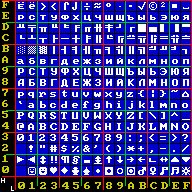Top Qs
Timeline
Chat
Perspective
Nibble
Four-bit unit of binary data From Wikipedia, the free encyclopedia
Remove ads
In computing, a nibble,[1] also spelled nybble to match byte, is a unit of information that is an aggregation of four-bits; half of a byte/octet.[1][2][3] The unit is alternatively called nyble, nybl, half-byte[4] or tetrade.[5][6] In networking or telecommunications, the unit is often called a semi-octet,[7] quadbit,[8] or quartet.[9][10]
This article needs additional citations for verification. (April 2015) |

As a nibble can represent sixteen (24) possible values, a nibble value is often shown as a hexadecimal digit (hex digit).[11] A byte is two nibbles, and therefore, a value can be shown as two hex digits.
Four-bit computers use nibble-sized data for storage and operations; as the word unit. Such computers were used in early microprocessors, pocket calculators and pocket computers. They continue to be used in some microcontrollers. In this context, 4-bit groups were sometimes also called characters[12] rather than nibbles.[1]
Remove ads
History
The term nibble originates from its representing half a byte, with byte a homophone of the English word bite.[4]
Around 1958, David B. Benson might have originated the term. As a professor emeritus at Washington State University in a 2014 interview, he recalled that he playfully used (and might have possibly coined) the term nibble as half a byte and unit of storage required to hold a binary-coded decimal (BCD) digit when talking to a programmer from Los Alamos Scientific Laboratory at that time.[citation needed]
In 1977, an early use of the spelling nybble for the term was recorded within the consumer-banking technology group at Citibank. It created a pre-ISO 8583 standard for transactional messages between cash machines and Citibank's data centers that used the basic data unit nabble.[citation needed]
In the early 1980s, the alternative spelling nybble reflected the spelling of byte, as noted in editorials of Kilobaud and Byte.[citation needed]
Remove ads
Usage
Summarize
Perspective
Nibble is used to describe the amount of memory used to store a digit of a number stored in packed decimal format (BCD) within an IBM mainframe. This technique is used to make computations faster and debugging easier. An 8-bit byte is split in half and each nibble is used to store one decimal digit. The last (rightmost) nibble of the variable is reserved for the sign. Thus a variable which can store up to nine digits would be "packed" into 5 bytes. Ease of debugging resulted from the numbers' being readable in a hex dump where two hex numbers are used to represent the value of a byte, as 16×16 = 28. For example, a five-byte BCD value of 31 41 59 26 5C represents a decimal value of +314159265.[citation needed]
Historically, nybble was used in many cases for a group of bits greater than 4. On the Apple II, much of the disk drive control and group-coded recording was implemented in software. Writing data to a disk was done by converting 256-byte pages into sets of 5-bit (later, 6-bit) nibbles and loading disk data required the reverse.[13][14][15] Moreover, 1982 documentation for the Integrated Woz Machine refers consistently to an "8 bit nibble".[16] The term byte once had the same ambiguity and meant a set of bits but not necessarily 8, hence the distinction of bytes and octets or of nibbles and quartets (or quadbits). Today, the terms byte and nibble almost always refer to 8-bit and 4-bit collections, respectively, and are very rarely used to express any other sizes.[citation needed]
Remove ads
Value representation
A nibble-sized value can be represented in different numeric bases:
Low and high nibbles
The low and high nibbles of a byte are its two halves, which are the least and the most significant bits within the byte, respectively. In a graphical representation of bits within a byte, the leftmost bit could represent the most significant bit (MSB), corresponding to ordinary decimal notation in which the digit at the left of a number is the most significant. In such an illustration, the four bits on the left end of the byte form the high nibble, and the remaining four bits form the low nibble.[17] For example,
- ninety-seven = 9710 = (0110 0001)2 = 6116
the high nibble is 01102 (616), and the low nibble is 00012 (116). The total value is high-nibble × 1610 + low-nibble (6 × 16 + 1 = 9710).
Remove ads
See also
- Binary number – Number expressed in the base-2 numeral system
- Syllable – A platform-specific data size used for some historical digital hardware
- Word – Base memory unit handled by a computer
References
External links
Wikiwand - on
Seamless Wikipedia browsing. On steroids.
Remove ads
